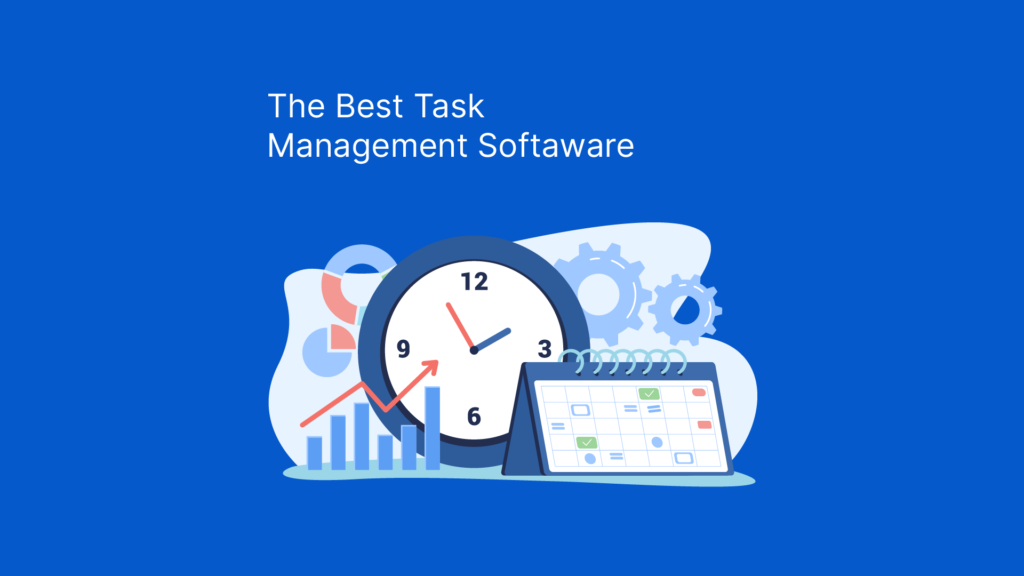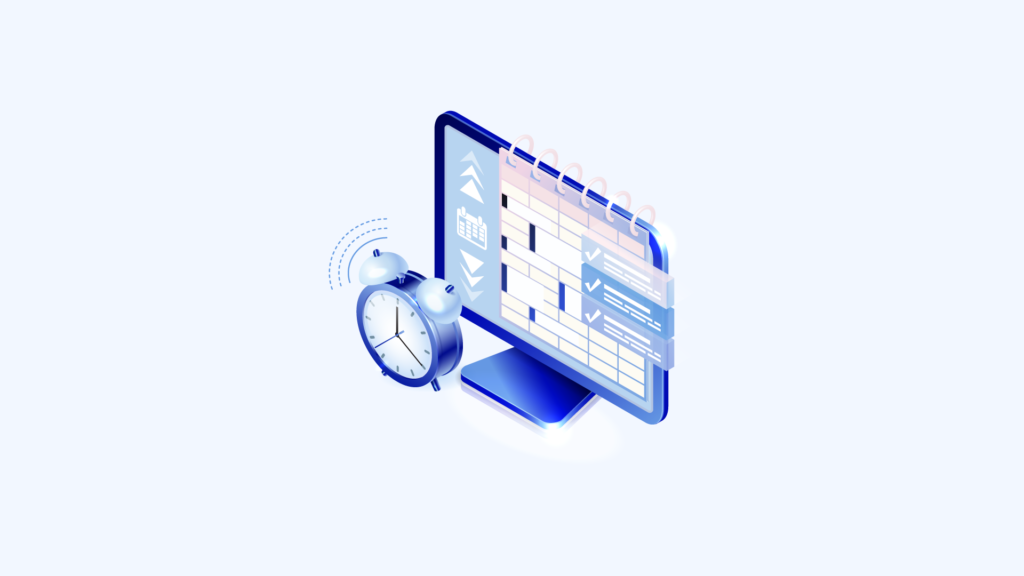In the dynamic world of software development, managing the entire lifecycle of an application—from initial idea to retirement—is crucial for success. Application lifecycle management software provides a strategic framework and tools for overseeing this process, ensuring collaboration, traceability, and quality at every stage.
ALM tools are indispensable for teams aiming to deliver high-quality software products efficiently while adapting to the complexities of modern development.
Here, we explore the top 10 ALM software solutions for 2025, highlighting their features, benefits, and drawbacks to help you make an informed choice.
What is Application Lifecycle Management (ALM)?
Application Lifecycle Management (ALM) is the strategic process of managing every stage of a software application’s lifecycle, from its initial concept through design, development, testing, deployment, and eventual retirement.
Collaboration: ALM fosters seamless communication and collaboration across cross-functional teams.
Complexity Management: It simplifies the intricacies of modern software development by streamlining processes and integrating tools.
Foundational Discipline: ALM establishes a strong framework for building successful products, empowering teams, and driving organizational success.
Benefits of ALM in Software Development
Enhanced Collaboration: ALM bridges the gap between developers, testers, and business teams by providing a centralized platform for communication.
Accelerated Time-to-Market: Application lifecycle management tools streamline processes and automation, shortening development cycles and enabling faster software delivery.
Improved Quality and Reliability: By integrating testing and quality assurance into every phase, ALM ensures higher product quality.
Cost Efficiency: Automation and process optimization reduce manual effort and minimize errors, resulting in cost savings.
Regulatory Compliance: Built-in governance features simplify adherence to industry-specific regulations and standards.
The Software Development Lifecycle (SDLC)
The Software Development Lifecycle (SDLC) focuses specifically on the stages involved in software development:
ALM vs. SDLC: While SDLC emphasizes the technical aspects of creating software, ALM takes a holistic approach by encompassing governance, collaboration, and maintenance.
Core Stages of SDLC: Planning, design, development, testing, deployment, and maintenance within the application development process.
ALM’s Role in SDLC: ALM integrates these stages into a unified workflow, ensuring alignment with business objectives and quality standards.
Key ALM Capabilities
Requirements Management:
Captures market needs and aligns them with project goals.
Ensures all team members have a shared understanding of project objectives.
Software Development:
Supports coding, integration, and debugging.
Encourages collaboration between developers using shared repositories and CI/CD pipelines.
Quality Assurance and Testing:
Embeds testing into every lifecycle stage to identify issues early.
Reduces the cost of fixing defects by ensuring thorough validation.
Agile Project Management:
An application lifecycle management solution encourages flexibility and adaptability to changing requirements.
Promotes iterative development, continuous improvement, and teamwork.
Stages of the Application Lifecycle Management Process
The Application Lifecycle Management (ALM) process involves several stages that help organizations manage the entire lifecycle of an application, from conception to retirement. Here are the key stages of the ALM process:
Requirements Management: This initial stage involves gathering and documenting the application’s requirements, including both functional and non-functional aspects. ALM tools play a crucial role in managing and prioritizing these requirements, ensuring that all team members are aligned and working towards the same objectives.
Design: During the design stage, the application’s architecture and design are created, encompassing the user interface, data models, and system architecture. ALM tools provide essential features for design management, such as version control and collaboration, to ensure that the design meets the specified requirements.
Development: This stage involves the actual development of the application, including coding, testing, and debugging. ALM tools support development management by offering project planning, task management, and version control features, facilitating a smooth and efficient development process.
Testing and Quality Assurance: In this critical stage, the application is rigorously tested and validated to ensure it meets the requirements and is free from defects. ALM tools provide comprehensive testing and quality assurance features, such as test case management, defect tracking, and continuous integration, to maintain high software quality.
Deployment: The deployment stage involves moving the application to production, including creating deployment scripts, managing configurations, and overseeing release management. ALM tools offer deployment management features like automated deployment, rollbacks, and monitoring to ensure a seamless transition to production.
Maintenance and Support: In the final stage, the application is maintained and supported through bug fixing, patching, and updates. ALM tools provide maintenance and support features, such as incident management, problem management, and change management, to ensure the application remains functional and up-to-date throughout its lifecycle.
Choosing the Right ALM Software
Selecting the right ALM software is crucial for the success of an organization’s software development process. Here are some key factors to consider when choosing an ALM software:
Requirements Management: Ensure the ALM software offers robust requirements management features, including requirements gathering, prioritization, and traceability. This helps in aligning the development process with business goals.
Project Management: Look for ALM software that provides comprehensive project management features, such as project planning, task management, and resource allocation. Effective project management tools are essential for keeping the development process on track.
Development Management: Choose ALM software that supports development management with features like version control, code review, and continuous integration. These tools help streamline the coding process and maintain code quality.
Testing and Quality Assurance: Opt for ALM software that includes testing and quality assurance features, such as test case management, defect tracking, and continuous testing. These features are vital for ensuring the delivery of high-quality software.
Deployment Management: Select ALM software that offers deployment management features, including automated deployment, rollbacks, and monitoring. Efficient deployment tools are crucial for a smooth transition from development to production.
Integration: Consider ALM software that integrates seamlessly with other tools and systems, such as version control systems, project management tools, and continuous integration servers. Integration capabilities enhance workflow efficiency and collaboration.
Scalability: Ensure the ALM software is scalable and can grow with your organization’s needs. Scalable solutions can accommodate increasing project complexity and team size.
User Interface: Choose ALM software with a user-friendly interface that is easy to navigate. A well-designed interface improves user adoption and productivity.
What is the Best ALM software?
1. Azure DevOps
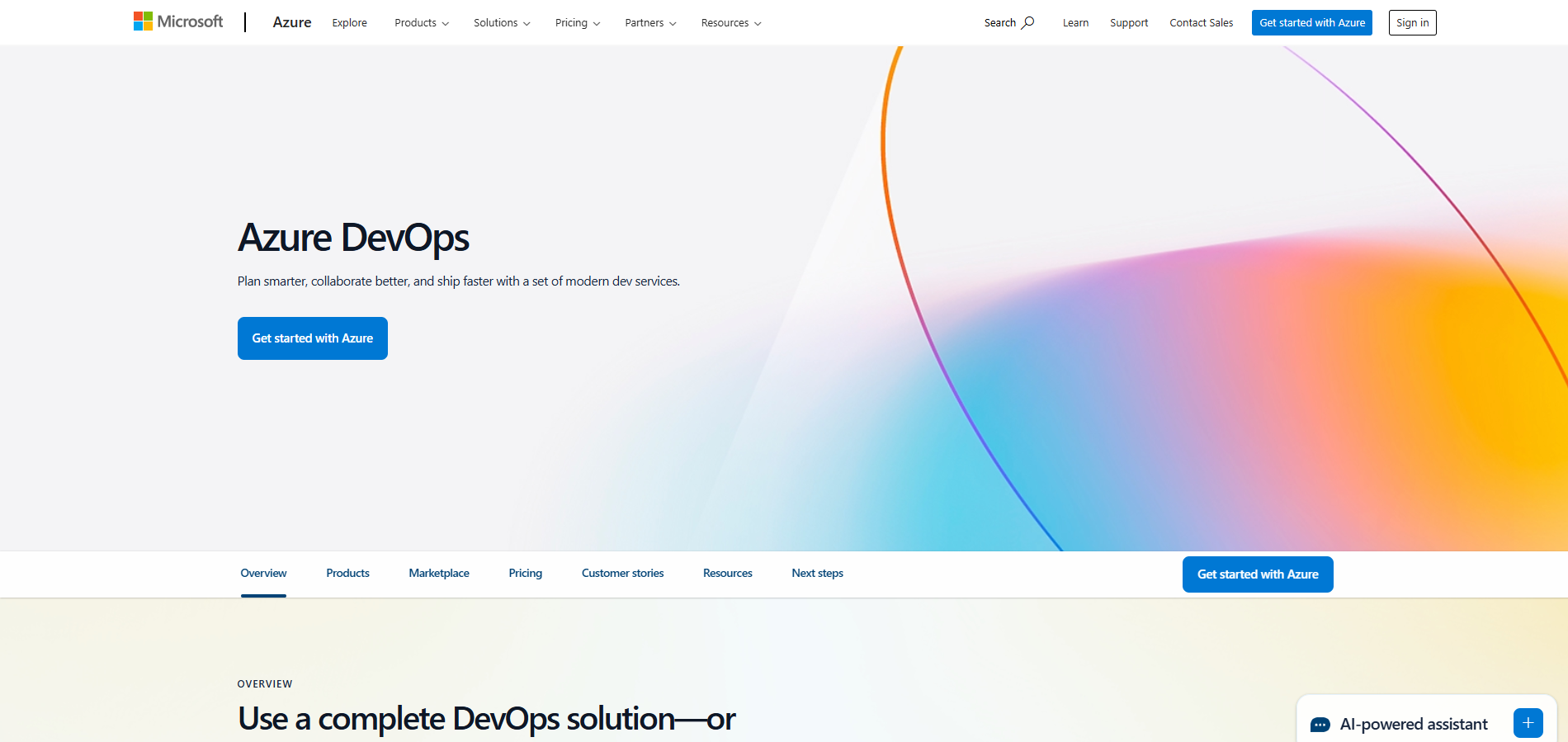
Azure DevOps is a powerful and comprehensive application lifecycle management solution, offering tools for every phase of the application lifecycle. With CI/CD pipelines, repository integration, and agile boards, it simplifies development and deployment processes while fostering team collaboration.
Features
Continuous Integration/Continuous Deployment (CI/CD) pipelines.
Repository hosting with version control.
Agile boards for sprint planning and task tracking.
Integrated test planning for quality assurance.
Pros
Unified platform for end-to-end ALM needs.
Seamless integration with Microsoft tools.
Scalable for teams of all sizes.
Cons
Pricing can increase for larger teams.
Requires technical expertise for optimal setup.
Cost: Free for basic use; starts at $6/user/month.
2. Micro Focus ALM/QC

Micro Focus ALM/QC is a feature-rich solution designed for compliance-heavy industries. It excels in requirements management, defect tracking, and release planning, offering robust traceability and audit capabilities.
Features
Advanced requirements and release management tools.
Comprehensive defect tracking with analytics.
Audit trails for regulatory compliance.
Pros
Exceptional traceability across the lifecycle.
Strong compliance and governance tools.
Scalable for enterprise use.
Cons
Outdated user interface compared to newer tools.
High cost may deter smaller teams.
Cost: Custom pricing.
3. Jira Align
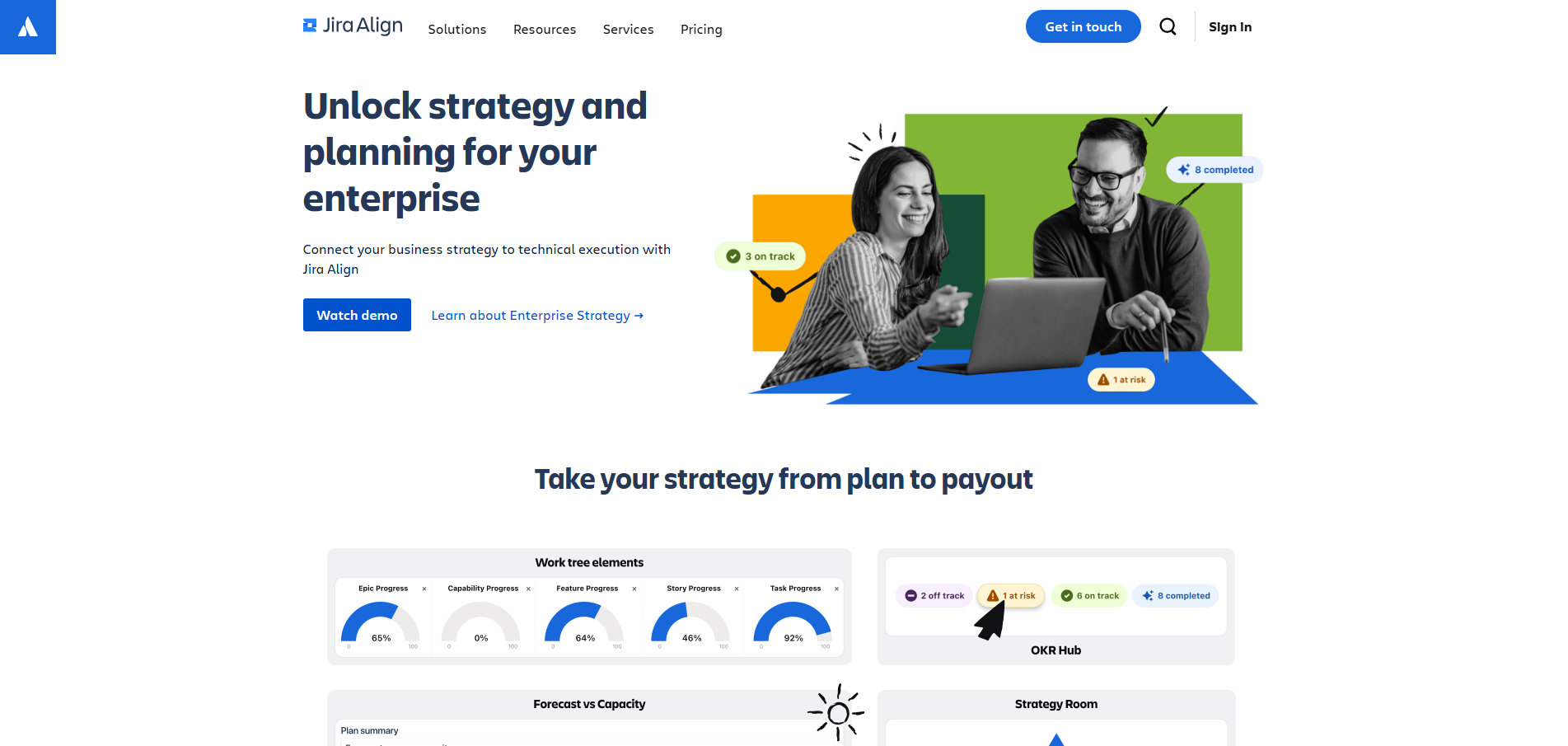
Jira Align connects strategic objectives with agile execution, making it a top choice for organizations scaling agile practices. With robust reporting and portfolio management, it ensures alignment and transparency.
Features
Strategic portfolio management tools.
Support for agile frameworks like SAFe and LeSS.
Real-time reporting for data-driven decisions.
Pros
Ideal for organizations managing multiple agile teams.
Comprehensive reporting capabilities.
Seamlessly integrates with Jira Software.
Cons
Steep learning curve for new users.
Custom pricing may not suit smaller organizations.
Cost: Custom pricing.
4. Helix ALM
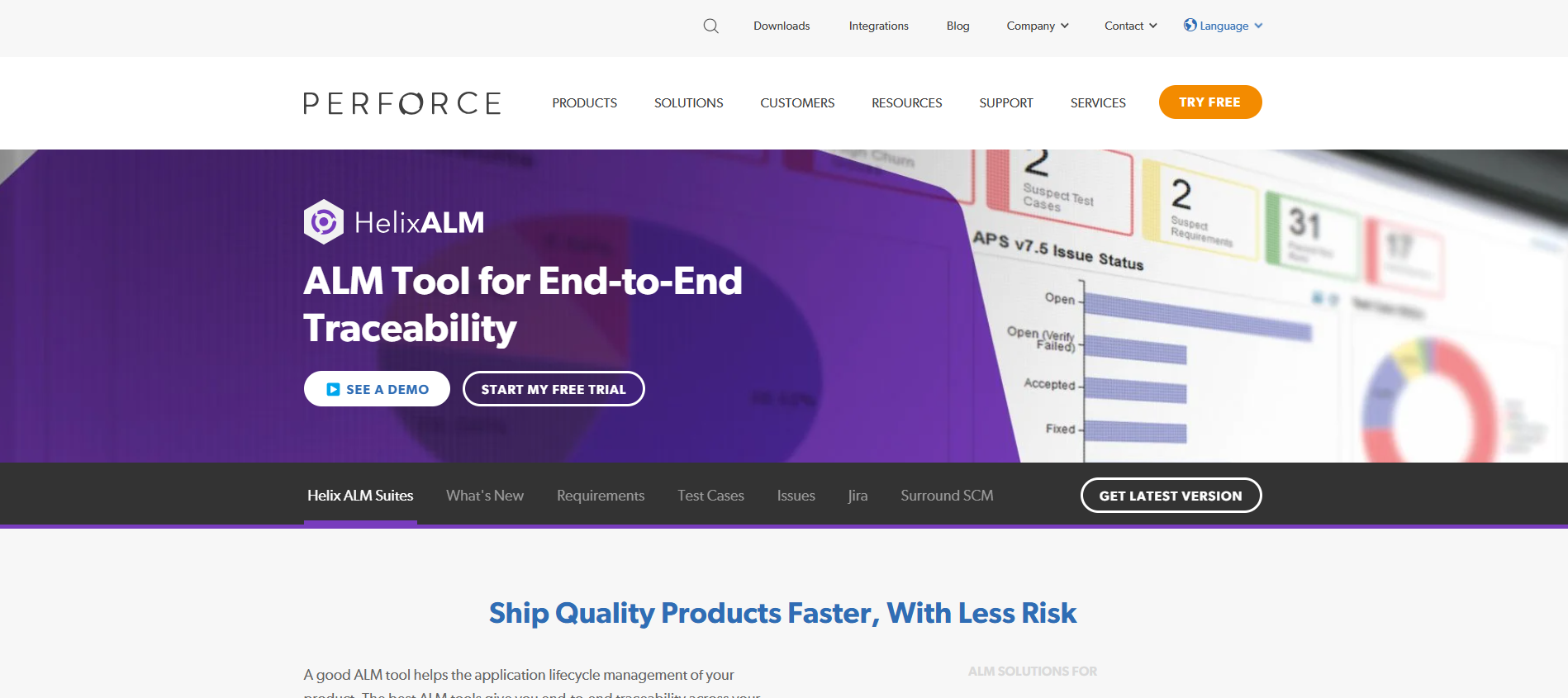
Helix ALM is ideal for teams prioritizing compliance and quality assurance. Its granular control over traceability and robust test case management make it a standout choice for regulated industries.
Features
Comprehensive test case and issue tracking.
Integration with development tools for seamless workflows.
Traceability across project artifacts.
Pros
Robust compliance tools for regulated industries.
Highly customizable to fit team needs.
Excellent support for distributed teams.
Cons
Overwhelming for smaller teams due to advanced features.
Pricing tailored for enterprises.
Cost: Custom pricing.
5. Polarion ALM
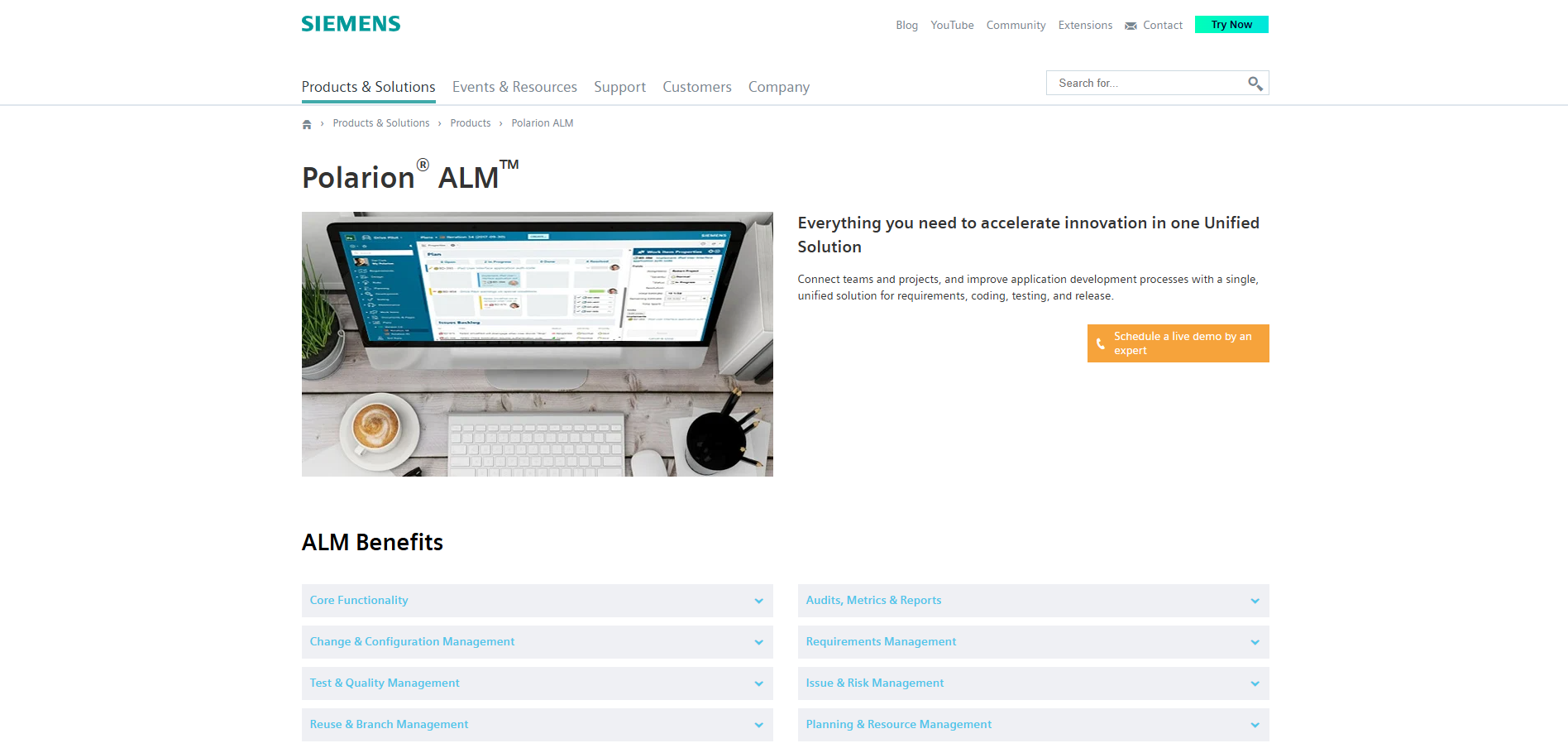
Polarion ALM excels in workflow automation and compliance, offering tools tailored for highly regulated environments. With electronic signatures and real-time collaboration, it’s a trusted choice for enterprises.
Features
Automated workflows to streamline processes.
Built-in compliance tools.
Real-time collaboration for global teams.
Pros
Strong compliance and audit preparation support.
Highly customizable workflows.
Excellent document collaboration features.
Cons
Steeper learning curve for new users.
Setup may require significant time and resources.
Cost: Custom pricing.
6. Atlassian Bitbucket
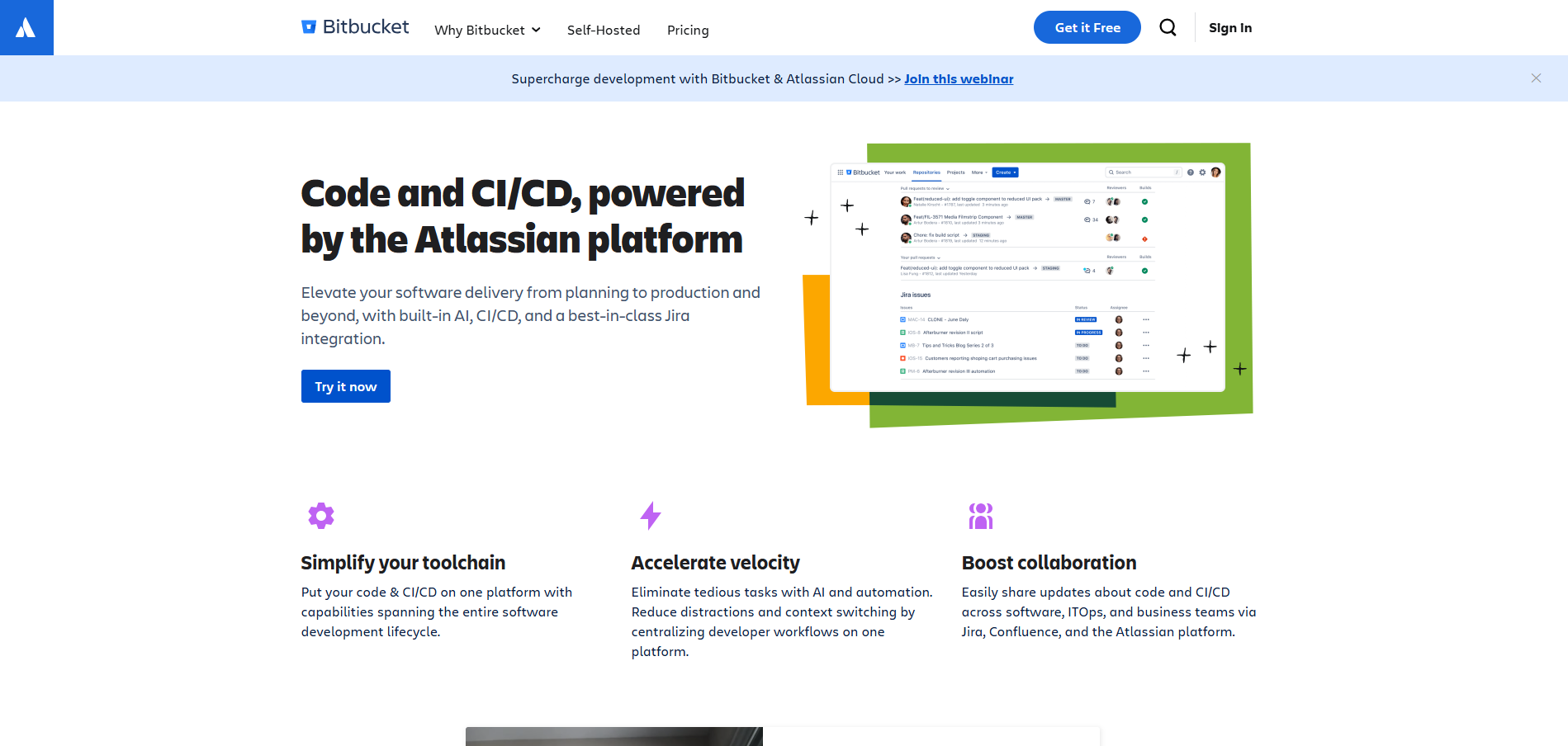
Atlassian Bitbucket is a lightweight ALM solution focused on repository hosting and CI/CD pipelines. It’s an excellent tool for agile teams managing iterative development.
Features
Repository hosting with built-in CI/CD.
Integration with Jira for task management.
Lightweight collaboration tools.
Pros
Affordable for small teams.
Strong integration with Atlassian’s ecosystem.
Easy to set up and use.
Cons
Limited functionality outside repository hosting.
Not ideal for comprehensive ALM needs.
Cost: Free for basic; starts at $3/user/month.
7. Rocket Aldon
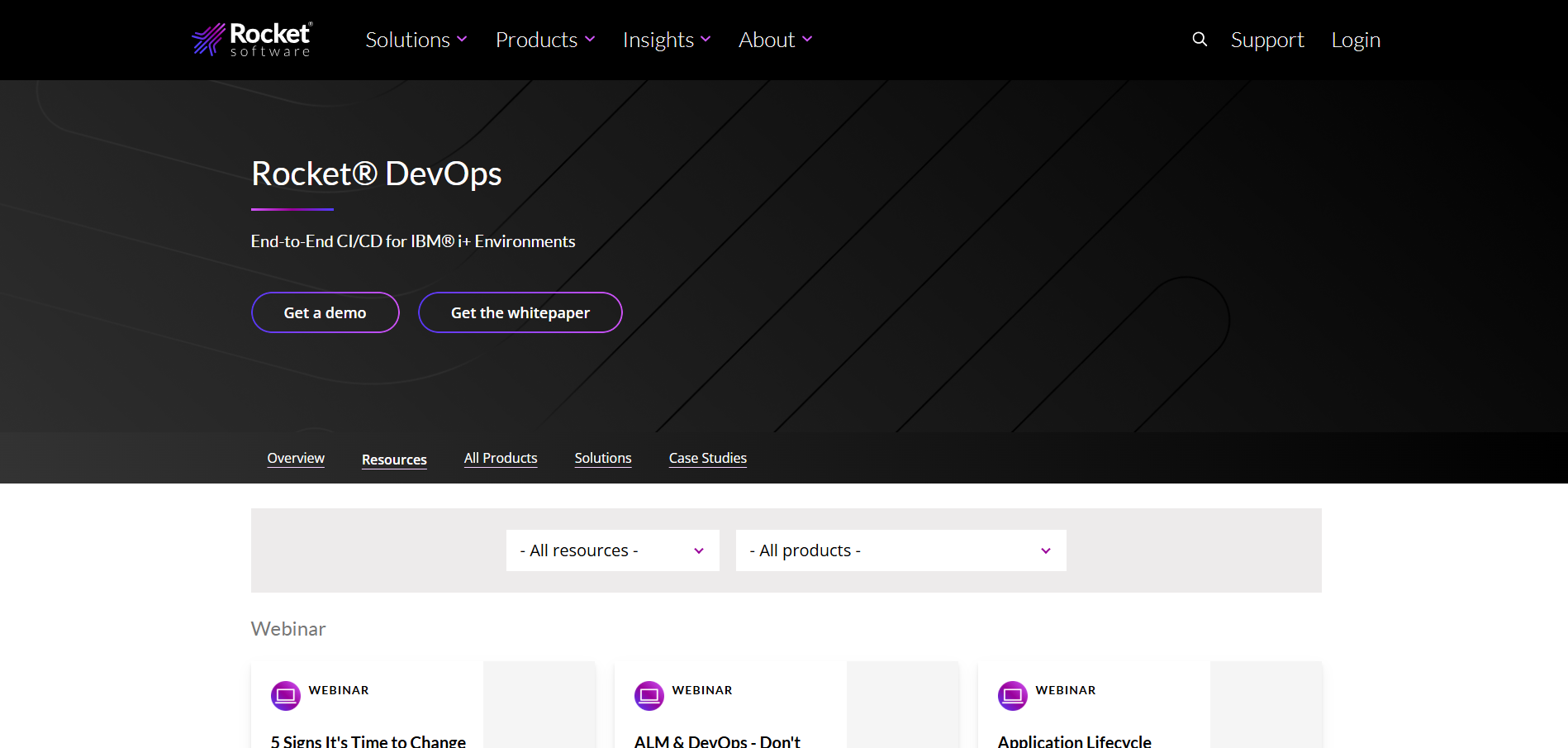
Rocket Aldon specializes in managing complex systems with tools for change management, version control, and audit trails. It’s particularly valuable for organizations with intricate workflows.
Features
Change and version control for large projects.
Comprehensive audit trail capabilities.
Tools for managing compliance and governance.
Pros
Exceptional for managing complexity in large environments.
Strong focus on compliance and traceability.
Scalable for enterprise projects.
Cons
Limited customization options compared to newer tools.
High cost for smaller organizations.
Cost: Custom pricing.
8. codebeamer
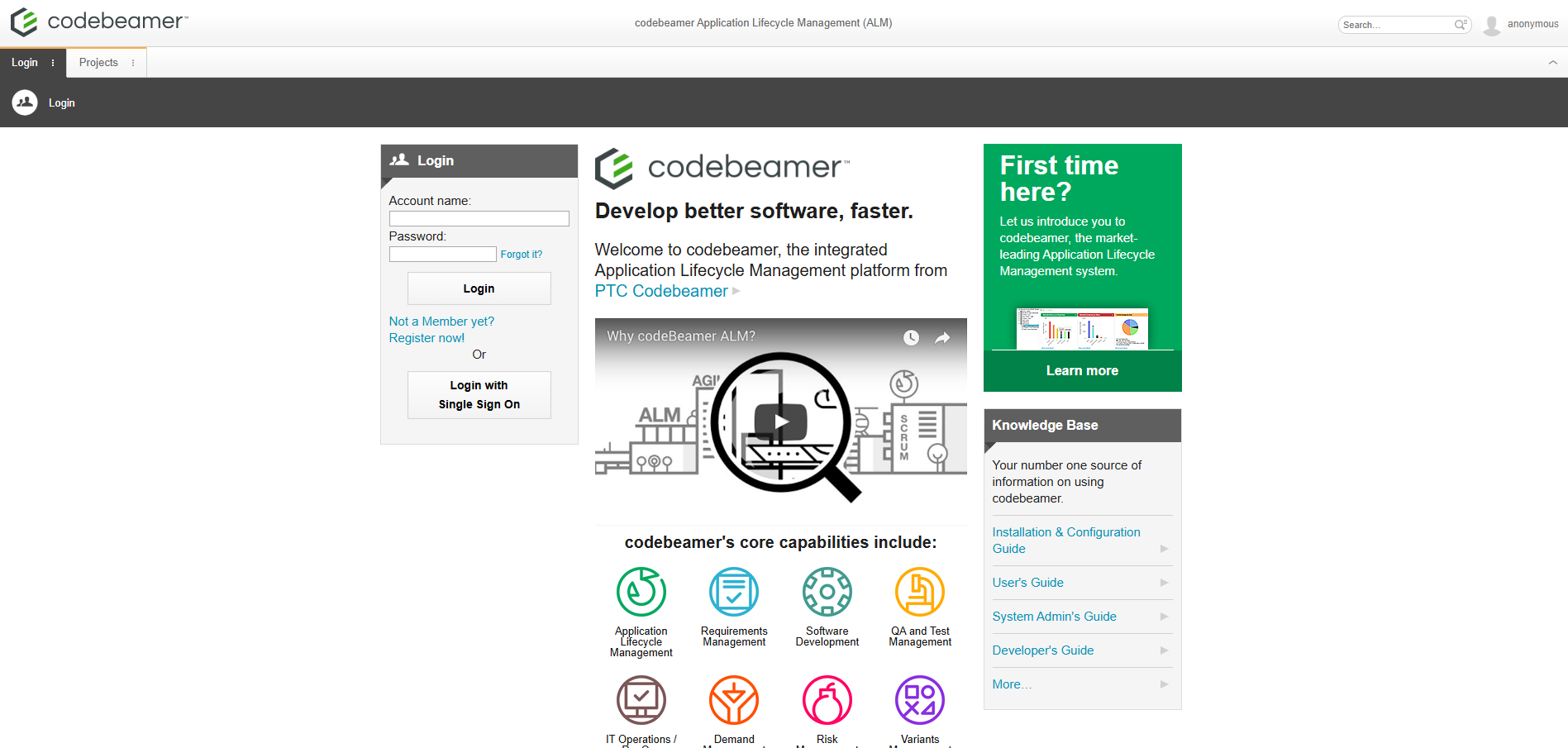
codebeamer, developed by Inland Software, is tailored for safety-critical industries. Its focus on traceability, compliance, and advanced integrations makes it a top choice for highly regulated sectors.
Features
Advanced traceability and requirements management.
Integrated compliance tools.
Agile and DevOps workflows.
Pros
Ideal for safety-critical industries like healthcare and automotive.
Comprehensive compliance support.
Scalable for large teams.
Cons
High pricing may deter smaller organizations.
Requires expertise for optimal implementation.
Cost: Custom pricing.
9. Tuleap
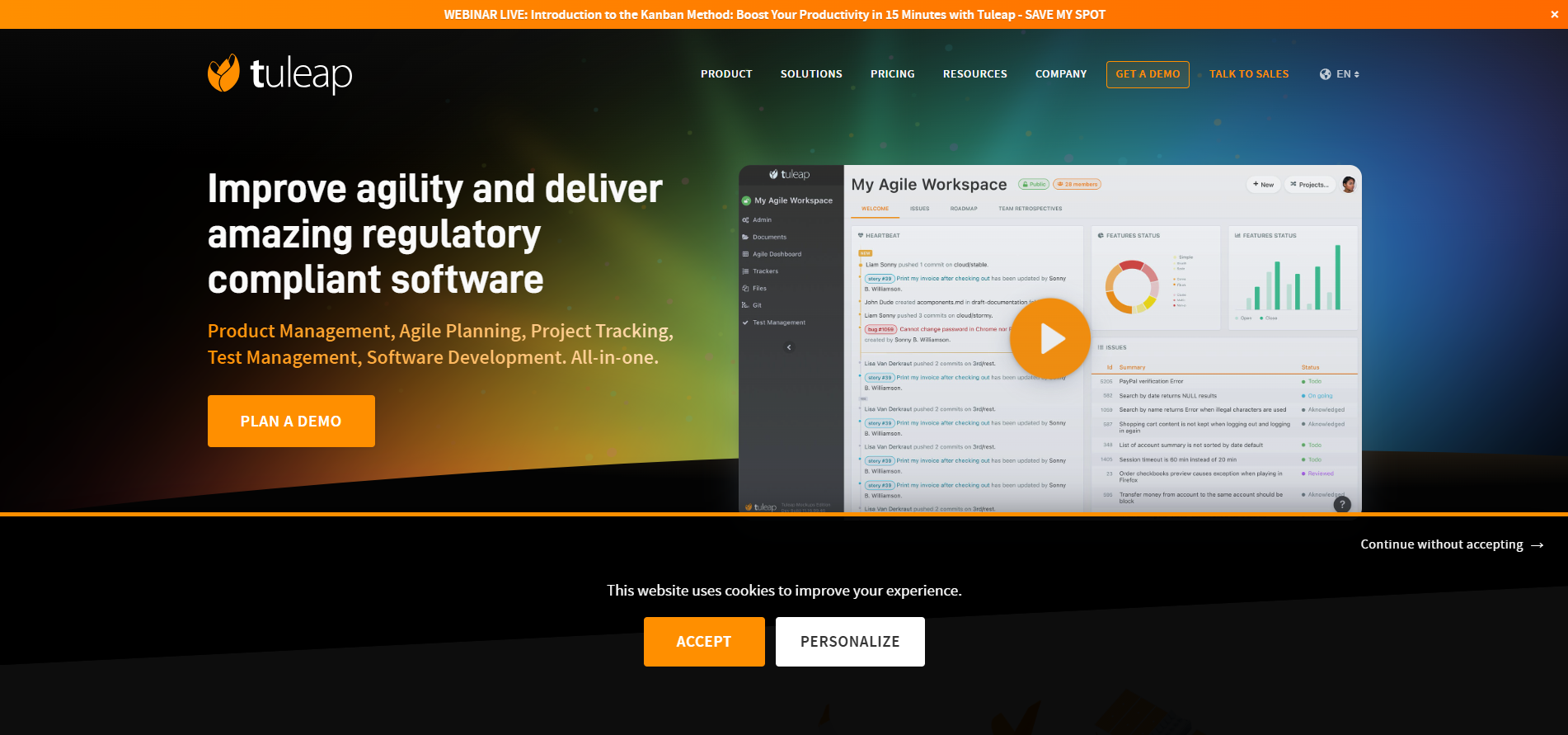
Tuleap is an open-source ALM solution that combines flexibility with robust features for agile and DevOps teams. Its enterprise-grade capabilities make it suitable for teams seeking cost-effective solutions.
Features
Agile project management with customizable boards.
Collaboration tools for distributed teams.
Open-source flexibility for tailored solutions.
Pros
Free for basic use, making it accessible for startups.
Highly customizable due to its open-source nature.
Supports agile and DevOps workflows effectively.
Cons
Limited support compared to commercial ALM tools.
Customization may require technical expertise.
Cost: Free for basic; custom pricing for enterprise needs.
10. SpiraTeam
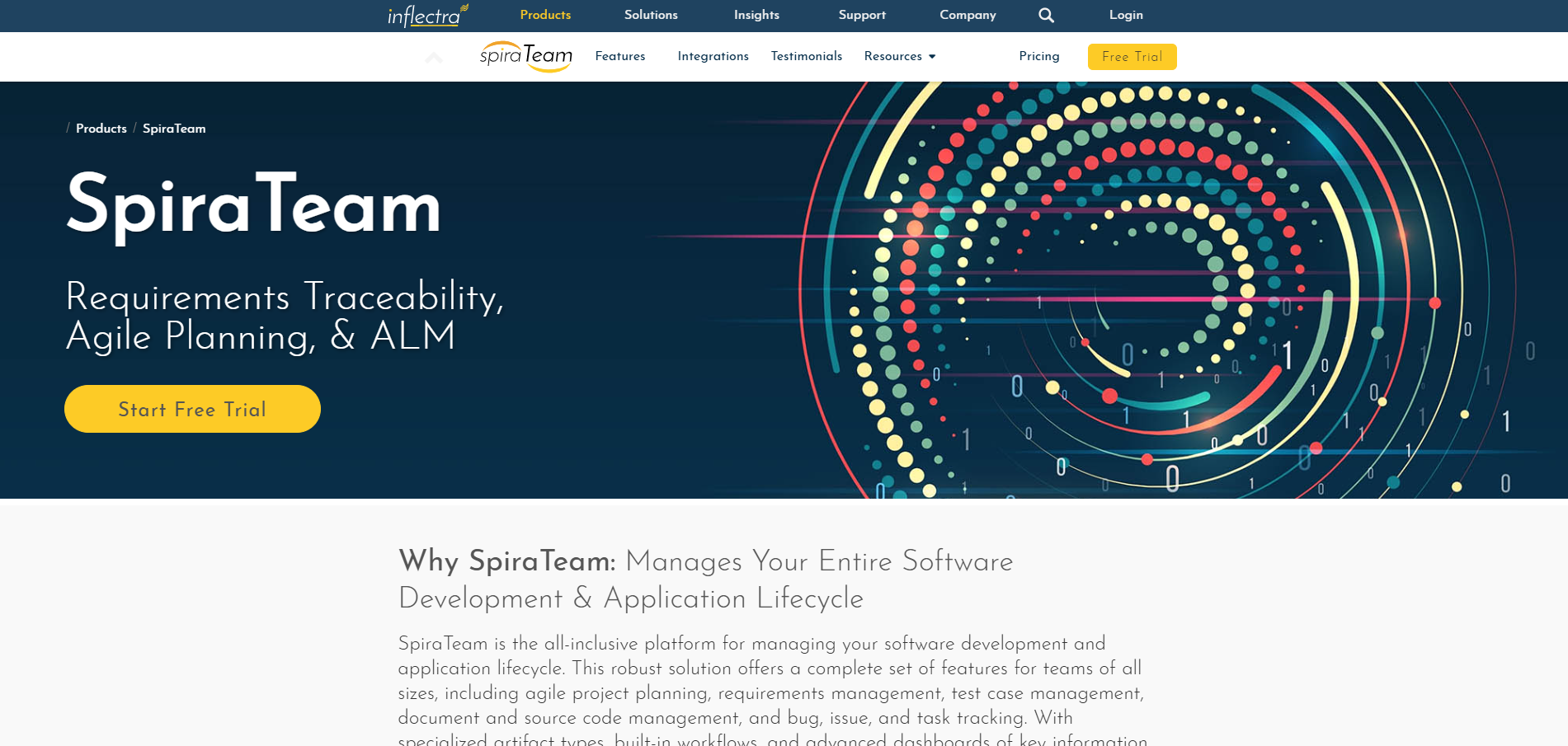
SpiraTeam is an award-winning ALM solution that combines requirements, releases, iterations, tasks, defects, and code management in a single environment. With robust test case management and customizable workflows, it’s ideal for program planning and baseline management.
Features
Comprehensive requirements and test management modules.
Customizable workflows for tailored processes.
Tools for bug, issue, and task tracking.
Pros
Combines test and project management for a holistic ALM approach.
Supports Agile, Waterfall, and hybrid methodologies.
Built-in risk management for proactive planning.
Cons
Steeper learning curve for users unfamiliar with ALM platforms.
Limited scalability for very large enterprise projects.
Cost: Starting at $1,717/year for three concurrent users.
Implementing ALM in Your Software Development Process
Implementing ALM in your software development process can significantly improve collaboration, reduce costs, and increase efficiency. Here are some steps to follow when implementing ALM:
Define Your ALM Process: Start by defining your ALM process, identifying the stages and activities involved in the application lifecycle. This provides a clear roadmap for managing the development process.
Choose the Right ALM Software: Select an ALM software that meets your organization’s needs and offers the necessary features and functionality to support your ALM process. The right tool can make a significant difference in the efficiency of your development process.
Configure the ALM Software: Configure the ALM software to align with your organization’s specific needs and requirements. Customizing the tool ensures it supports your unique workflows and processes.
Train Your Team: Provide comprehensive training for your team on the ALM software and the ALM process. Ensure they understand the stages and activities involved, as well as how to use the software effectively.
Monitor and Evaluate: Continuously monitor and evaluate the effectiveness of the ALM process and the ALM software. Gather feedback from your team and make adjustments as needed to improve efficiency and outcomes.
Continuously Improve: Look for opportunities to automate and streamline processes, and continuously improve the ALM process and the ALM software. Regularly updating and refining your approach ensures ongoing efficiency and effectiveness.
By following these steps, organizations can successfully implement ALM in their software development process, leading to improved collaboration, reduced costs, and increased efficiency.
Conclusion
Application Lifecycle Management (ALM) software is the backbone of successful software development in 2025, enabling teams to collaborate efficiently, streamline workflows, and deliver high-quality products.
From the comprehensive capabilities of Azure DevOps and Micro Focus ALM/QC to the open-source flexibility of Tuleap and the robust planning tools of SpiraTeam, there’s a solution to fit every organization’s needs. By evaluating and implementing the right ALM tools, your team can achieve its goals and drive innovation well into the future.
Frequently Asked Questions (FAQ)
What is the ALM life cycle?
The ALM life cycle encompasses the entire process of managing a software application from inception to retirement. This includes phases such as planning, development, testing, deployment, maintenance, and eventual decommissioning. ALM ensures that all aspects of the application’s lifecycle are managed effectively to deliver high-quality software.
What is the ALM tool used for?
ALM tools are used to facilitate the management of the software development lifecycle. They provide a centralized platform for collaboration, project management, requirements management, quality assurance, and more. These tools help streamline processes, improve communication, and ensure alignment with business objectives.
Is Jira an ALM tool?
Yes, Jira can be considered an ALM tool, particularly when used in conjunction with other Atlassian products like Jira Align and Bitbucket. It provides capabilities for agile project management, issue tracking, and collaboration, making it suitable for managing various aspects of the application lifecycle.
What does ALM mean in agile?
In agile development, ALM refers to the management of the entire lifecycle of an application in a way that supports agile methodologies. This includes facilitating iterative development, continuous integration, and collaboration among agile teams. ALM tools help agile teams manage changing requirements and deliver software efficiently.
How does ALM benefit software development?
ALM benefits software development by enhancing collaboration, accelerating time-to-market, improving quality and reliability, increasing cost efficiency, and ensuring regulatory compliance. By integrating various stages of the software development process, ALM provides a comprehensive approach to managing the application’s lifecycle.
Can ALM tools integrate with other software development tools?
Yes, most ALM tools offer integration capabilities with other software development tools such as CI/CD pipelines, version control systems, and testing frameworks. This seamless integration allows development teams to use multiple tools within a unified workflow, enhancing efficiency and productivity.
What is the difference between ALM and PLM?
ALM (Application Lifecycle Management) focuses on managing the lifecycle of software applications, while PLM (Product Lifecycle Management) is concerned with the lifecycle of physical products. While both involve lifecycle management, ALM is specific to software development processes, whereas PLM deals with the development and management of tangible products.





